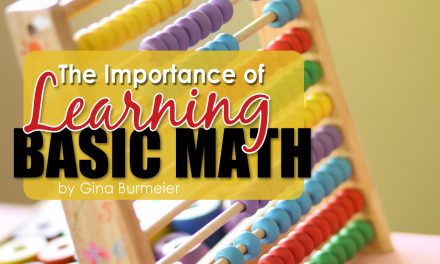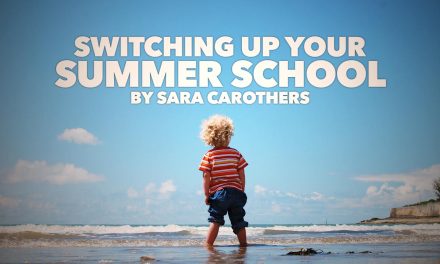We use The Well-Trained Mind as a guide in our homeschool, sort of like a spring board for advice, information and guidance through our homeschooling years. I appreciate the style of writing as though the authors and I are talking, mother to mother. I love the advice and wisdom given, how they share their own homeschooling stories, and how the book reassures parents that homeschooling is something they can do successfully. I like the classical approach to education is explained and the ideas for ways you can accomplish this approach in your own home.
However, what I have come to realize in my homeschool journey is that overall, the book is written as though you are homeschooling one child in one grade at a time. So when I would plan for each of my 3 school-aged children, their work loads and schedules would look great. . . separately, that is. But, when I put those schedules together, I was easily overwhelmed. Put babies and toddlers in the mix and some days were just disastrous! Here’s how I’ve tweaked The Well-Trained Mind so that our homeschooling is not so stressful.
#1. Combine, Combine, Combine
Now this may seem like a no-brainer, especially to an experienced homeschooler or to a mother of many. But let me tell you, I desperately needed to hear someone say that to me early on. After using public school for 3 years, we were new homeschoolers, and I had a new baby every year for our first three years of homeschooling. Large family living was also new and I was learning my way through that–all while still trying to teach most everything separately.
Long story short, save yourself the trouble of trying to keep track of a thousand different subjects, especially during the elementary to middle school years. Here’s what we (finally!) combine: History, Science, Health, Music, Art, P.E., Bible and some Latin. I think Math and Language Arts are good to keep separate according to ability.
I certainly require different work in each subject for each child, so my 3rd grader’s assignments will look different from my 7th grader’s. It is such a time saver and stress reliever to have the children study subjects together. It teaches them to work together with someone of a different age and level of ability and makes the planning easier on me.
#2. One-on-One Isn’t (Always) Realistic
To piggyback off of the previous point, one-on-one time for every person, for every subject just won’t work. Seriously. I’m only one mom without the ability to clone myself. Some of the curriculum suggestions and teaching methods in the book require a great deal of one-on-one time across subjects. My advice is this: choose curriculum/subjects wisely and aim for independence.
For example, when my oldest daughter was in 3rd grade, our grammar study was just heavy with one-on-one teaching, all laid out with a scripted text for me on what to say to her. My daughter could not breathe under that formatting (poor child!), because she just didn’t need me to hold her hand through that. Fast-forward a few years and my 3rd grade son is thriving with that exact same grammar book.
So even if the book recommends it (whether that be a curriculum or a method of teaching), keep in mind your child may not need everything read and narrated aloud or dictated to them. Sometimes they need the freedom to read it themselves, mull it over, then apply what they’ve read. Remember the goal is to teach our children how to learn, to eventually move toward independence from mom.
Although I’m not there yet, high school is around the corner. This may be a season where for some studies, the high school student may have to veer away from what the group is studying to meet certain requirements. I think that if along the way, I’ve been slowly nudging my children toward independence (less scripted texts, less hand-holding, etc.), the high school years won’t seem so intimidating because they’ve been gaining experience in independence along the way.
#3. Revise the Time Frames
Now, to be fair, The Well-Trained Mind mentions that the time recommendations are simply given so that a parent has some idea how long it should take to complete assignments each day. However, new homeschoolers often stress themselves out trying to check every box and complete every task. Time frames is one of those areas, and I was one of those homeschooling mothers.
Do not be bound by the clock. Use the times as recommendations only. If your child needs 30 minutes for spelling instead of 15, give him 30 minutes. If your child can do an hour’s worth of math in 40 minutes, then don’t make him do 20 minutes more. If you cannot spare 90 minutes on one history period, try an hour instead. Do not lose one of the most beautiful aspects of homeschooling: flexibility.
Think of schooling as more of a natural extension of living and parenting, rather some imitation of a school day, in an actual school building, with set times for everything. Don’t get me wrong, we have a routine for each of our days and a working knowledge of how each day will flow. However, I know it is unrealistic for me to schedule every single assignment by the minute, especially because babies and toddlers could care less about the clock! Life happens around here–potty training in the middle of history, nursing sessions during math, someone needs help with English while I’m changing a diaper–you get the picture.
What happens is that in time, you begin to notice how long it takes for each child to complete what assignments and you begin to understand what the workload should look like. Be patient in this process. Also, as the kids get older and begin to grasp more concepts, their efficiency will increase. Be patient with this process as well. Keep at it and you will find your rhythm, but don’t stress out if all of your learning didn’t occur in neat little 15-30 minute chunks of time.
Finally, if the work’s not done by lunch time, STOP! Don’t go any further! Put it away until later in the afternoon or save it for the next day. Trust me. . .this will help you keep some sanity and avoid burn out.
#4. A Word on Science
I love The Well-Trained Mind’s approach to science, but only in theory. Coupling the period of history we’re studying with the science of the time seemed just fabulous. In reality, it was just a disaster for my family and here’s why. Most science curriculum do not take a classical approach, so the The Well-Trained Mind’s recommendation is to piece a curriculum together using various science encyclopedias, experiment books, science kits, and the like, for elementary through middle grades. It’s a real hands-on, find-out-how-it-works method to learning science.
At first glance, for one or maybe two children, I could totally see how this could work and be tons of fun. My reality is that 3 different experiments for 3 different areas of science had me all over the place. (I really tried, y’all!) And that’s right now; in one short year, I’ll have 4 school-aged children, with a few younger ones hanging around for the action. Furthermore, the cost for all the science kits and encyclopedias proved to be more than my budget would allow. I tried piecing things together with substitutes and cheaper alternatives, which became a stressful planning session each school year. Then, once I collected everything, it was like pulling teeth to get my children to buy into it all. So, I ditched The Well-Trained Mind for science and branched out on my own. (Don’t be like me and take years to figure that out!)
Science is a subject we now do together. We are using Science in the Beginning by Wile and it has been a HUGE blessing to our family. The experiments are straightforward and the explanations are thorough as it explains the science behind each day of Creation. The end-of-lesson assignments are already divided amongst younger, older and oldest students, but I still have room to add to or subtract from the assignments based on my children’s abilities. And the obvious bonus for our family: it is Creation-based, which means no evolutionists theories or millions of years, etc. So, if The Well-Trained Mind science recommendations do not work for you, ditch it and go with something else! You won’t be sorry you did!
These are the major adjustments we’ve made so that the Well Trained-Mind fits for our large family. If you use the Well-Trained Mind, what adjustments have you made so that it works well in your family? What tips do you have to make homeschooling with multiple grades a smoother experience?





